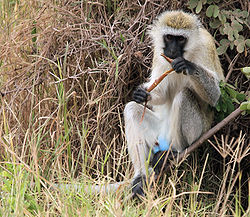The Primates Portal A primate is a member of the biological order Primates, the group that contains lemurs, the aye-aye, lorisids, galagos, tarsiers, monkeys, and apes, with the last category including great apes. With the exception of humans, who inhabit every continent on Earth, most primates live in tropical or subtropical regions of the Americas, Africa and Asia. Primates range in size from the 30-gram (1 oz) pygmy mouse lemur to the 200-kilogram (440 lb) mountain gorilla. According to fossil evidence, the primitive ancestors of primates may have existed in the late Cretaceous period around 65 mya (million years ago), and the oldest known primate is the Late Paleocene Plesiadapis, c. 55–58 mya. Molecular clock studies suggest that the primate branch may be even older, originating in the mid-Cretaceous period around 85 mya. Primates exhibit a wide range of characteristics. Some primates do not live primarily in trees, but all species possess adaptations for climbing trees. Locomotion techniques used include leaping from tree to tree, walking on two or four limbs, knuckle-walking, and swinging between branches of trees (known as brachiation). Primates are characterized by their large brains relative to other mammals. These features are most significant in monkeys and apes, and noticeably less so in lorises and lemurs. Many species are sexually dimorphic, which means males and females have different physical traits, including body mass, canine tooth size, and coloration.
Selected article
Gorillas are the largest of the living primates. They are ground-dwelling and predominantly herbivorous. They inhabit the forests of central Africa. Gorillas are divided into two species and (still under debate as of 2008) either four or five subspecies. Gorillas they are the next closest living relatives to humans after the two chimpanzee species. Gorillas live in tropical or subtropical forests. Although their range covers a small percentage of Africa, gorillas cover a wide range of elevations. The mountain gorilla inhabits the Albertine Rift montane cloud forests of the Virunga Volcanoes, ranging in altitude from 2225 to 4267 m (7300-14000 ft). Lowland gorillas live in dense forests and lowland swamps and marshes as low as sea level.
Selected picture The ring-tailed lemur (Lemur catta) is a large strepsirrhine primate and the most recognized lemur due to its long, black and white ringed tail. It belongs to Lemuridae, one of five lemur families, and is the only member of the Lemur genus. Like all lemurs it is endemic to the island of Madagascar. Known locally in Malagasy as maky (spelled maki in French) or hira, it inhabits gallery forests to spiny scrub in the southern regions of the island. It is omnivorous and the most terrestrial of lemurs. The animal is diurnal, being active exclusively in daylight hours. CategoriesSelected species Least Concern (IUCN 3.1)|Least Concern The vervet monkey (Chlorocebus pygerythrus), or simply vervet, is an Old World monkey of the family Cercopithecidae native to Africa. The term "vervet" is also used to refer to all the members of the genus Chlorocebus. The five distinct subspecies can be found mostly throughout Southern Africa, as well as some of the eastern countries. Vervets were transported to the islands of Barbados, Saint Kitts, and Nevis in conjunction with the African slave trade. These mostly vegetarian monkeys have black faces and grey body hair color, ranging in length from about 19 in (50 cm) for males to about 16 in (40 cm) for females. In addition to very interesting behavioral research on natural populations, vervet monkeys serve as a nonhuman primate model for understanding genetic and social behaviors of humans. They have been noted for having human-like characteristics, such as hypertension, anxiety, and social and dependent alcohol use. The most significant studies done on vervet monkeys involve their communication and alarm calls, specifically in regard to kin and group recognition and particular predator sightings. Did you know?
Primate lists
WikiProjectsThings to do
Associated WikimediaDiscover Wikipedia using portals |
© MMXXIII Rich X Search. We shall prevail. All rights reserved. Rich X Search

















